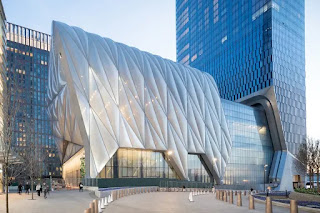Art/Music/Architecture Review: Modern Music at Manhattan's Newest Performance Space
Art/Music Review
Reich Richter Pärt
Art by Gerhard Richter
Music by Arvo Pärt and Steve Reich
The Shed, Hudson Yards, Manhattan
May 26, 2019
NYC’s newest performance venue is The Shed, part of the multi-gazillion
dollar real estate Hudson Yards development, built over the Long Island Railroad tracks
west of Penn Station. The development includes apartments priced for Russian
oligarchs, a luxury mall, an oddly ugly huge sculpture, and this new
performance venue, designed for maximum flexibility. It includes fixed art
gallery space and cool movable architectural “tarp” that can either decoratively cover the
permanent building (as in the first picture below), or roll leftwards on huge wheels to cover the adjacent plaza for various
installations and performances.
For a cool animation of how this works, look at the sixth panel down at this website.
The development as a whole has been rightly panned by critics as yet another NYC
extravagance for the ultrawealthy. I found the mall particularly appalling,
with working class tourists spending insane amounts of money on overpriced knickknacks
and artisanal microbites to eat in the luxury mall. Next to all of this is an
amber, rather ugly, pointless eight story sculpture called The Vessel, consisting of interweaving stairways to climb, but with
a top view blocked mostly by the surrounding skyscrapers. You actually need a
reservation and pay a fee to walk the stairways. It being New York, the waiting
list is currently two weeks! This could
have been interesting if it included Escher-like stairways to nowhere, or optical
illusions, but no. It is quite symmetric, and quite dull.
After this 15 minute segment, we moved to the adjoining
large hall. There, a full chamber orchestra (the excellent Ensemble Signal,
conducted by Brad Lubman) played a newly commissioned piece by Reich. This was
in fact a live film score for a hypnotic 30 minute film by artist Reich which
took the tapestries in the first room to a new level. An initial pattern of vertical colored
stripes continuously morphed into slowly moving patterns of all sorts, many
looking like repeated folk art figures, but all apparently created using a
mathematic process.
The notes described the artist’s creative process as
follows:
Using a computer image of the painting, he divided it vertically
into two halves and then divided those halves into quarters, making a mirror
image of two of the quarters. He then divided the painting into fourths, eighths,
16ths, and so on, up to 4096ths. Each step follows the exact same procedure of
divide, mirror, and repeat. The result is an abstract image that becomes a series
of increasingly dense patterns, and eventually solid bands of color.
This film, resonant of an acid trip, was an excellent pairing with the Reich score. The
conductor, facing away from the film, had a computer monitor so he could
coordinate the Reich chord/pattern changes with the changes in the image.
This was one of the better art-music pairings I have seen,
and while neither the art nor the music is in my favorite style (I am a little too logical for psychedelic art and chant-like music), it made
me think about how the styles could feed off each other. There was even some
resonance between these performances and the monstrous eight story sculpture outside. While the big picture
of The Vessel is dull, there are intriguing interlocking geometric metal surfaces that
make up its shell, and these divide their reflections into multiple parts, much
as the music and art did in the installation. So sometimes one can find
beauty midtown, even within an overpriced, gluttonous Manhattan monument to the 1%.






Comments
Post a Comment